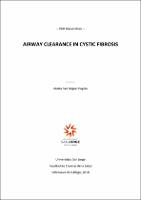Por favor, use este identificador para citar o enlazar este ítem:
https://repositorio.usj.es/handle/123456789/165
Registro completo de metadatos
| Campo DC | Valor | Lengua/Idioma |
|---|---|---|
| dc.contributor.advisor | Reychler, Grégory | - |
| dc.contributor.author | San Miguel Pagola, Marta | - |
| dc.date.accessioned | 2019-05-02T16:48:03Z | - |
| dc.date.available | 2019-05-02T16:48:03Z | - |
| dc.date.issued | 2019 | - |
| dc.date.submitted | 2018-12-21 | - |
| dc.identifier.uri | https://repositorio.usj.es/handle/123456789/165 | - |
| dc.description.abstract | INTRODUCTION Cystic fibrosis (CF) is a genetic disorder that occurs at a rate of ~1 in 4.500 births in the Caucasian population. Although the illness affects several body systems, the respiratory problems are the principal cause of morbidity and mortality. The dehydrated airway mucus and increased viscoelasticity that characterizes the secretions of this disorder, leads to mucociliary clearance impairment and progressive irreversible lung damage. Therapies to promote sputum removal, such as nebulized mucoactive treatments and airway clearance techniques (ACTs), are a cornerstone of daily CF treatment. Despite the high therapeutic burden of those therapies, there is little evidence to support the use of a specific procedure over another. The general aim of this PhD dissertation is to analyze the short-term effect of body posture and different modalities of airway clearance therapies in adults with stable CF. MATHERIAL AND METHODS Four studies were carried out: 1) a unicentric randomized crossover trial performed in a healthy population and focused on measuring the influence of left lateral decubitus positioning during nebulization on aerosol deposition (Clinical Trial Registration Number: NCT02451501); 2a) a multicentric randomized crossover trial directed to analyze the effect of combining mucoactive nebulization with an oscillatory ACT on sputum expectoration and related symptoms in adults with stable CF (NCT02303808); 2b) a subsequent in vitro experiment carried out to analyze the product loss of the circuit used for the combined nebulization; and 3) a multicentric randomized crossover trial, also performed in adults with stable CF, aiming to compare the efficacy of three airway clearance sessions composed of different ACT modalities (resistive inspiratory maneuver [RIM], autogenic drainage [AD] and RIM+AD) (NCT0226198). RESULTS Study 1: Nebulization in the left lateral decubitus position performed with a controlled dose breath-actuated nebulizer system (AKITA) reduces the total and regional amounts of drug delivered to the lungs, especially to the dependent regions. Study 2a: Combining regular mucoactive nebulization with an oscillatory ACT promotes greater sputum expectoration than usual care during the nebulization period, reducing symptoms related to sputum and mucoactive drug adverse effects. This combination does not affect the amount of sputum expectorated during post-nebulization ACT and 24 hours afterward. Study 2b: The connection between the nebulizer and the ACT device seems to reduce the amount of drug that reaches the patient. Study 3: RIM, AD (usual care) and RIM+AD are safe and well tolerated ACTs that enhance greater sputum expectoration than spontaneous breathing in adults with stable CF. AD and RIM+AD are equally effective to promote sputum removal. However, RIM generates significantly lower expectoration and, by itself, does not seem a good option to promote sputum removal in the CF population. Transversal result related to the studies 2a and 3: Patients prefer mucus clearance interventions different than usual care, as long as they are at least as effective. CONCLUSIONS The findings of this PhD dissertation suggest that nebulization performed in the left lateral decubitus in healthy males reduces the total and regional amounts of drug delivered to the lungs (especially in the dependent regions). Moreover, combining mucoactive nebulization with an oscillatory ACT enhances immediate sputum expectoration, reduces symptoms related to sputum and mitigates mucoactive adverse effects in adults with stable CF. Furthermore, airway clearance sessions that include slow expiratory ACTs seem more effective promoting immediate sputum removal in adults with stable CF than inspiratory maneuvers performed alone. | es_ES |
| dc.format.extent | 105 p. | es_ES |
| dc.format.mimetype | application/pdf | es_ES |
| dc.language.iso | eng | es_ES |
| dc.relation.requires | Requiere Adobe PDF | es_ES |
| dc.rights | Attribution-NonCommercial-NoDerivatives 4.0 Internacional | * |
| dc.rights.uri | http://creativecommons.org/licenses/by-nc-nd/4.0/ | * |
| dc.subject | Fisioterapia | es_ES |
| dc.title | Airway clearance in cystic fibrosis | es_ES |
| dc.type | doctoral thesis | es_ES |
| dc.rights.accessRights | open access | es_ES |
| dc.contributor.affiliation | Universidad San Jorge | es_ES |
| Aparece en las colecciones: | Facultad de Ciencias de la Salud | |
Ficheros en este ítem:
| Fichero | Descripción | Tamaño | Formato | |
|---|---|---|---|---|
| Airway clearance in cystic fibrosis.pdf | 2,32 MB | Adobe PDF |  Visualizar/Abrir |
Este ítem está sujeto a una licencia Creative Commons Licencia Creative Commons

